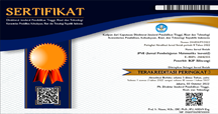ANALISIS KEMAMPUAN PEMECAHAN MASALAH MATEMATIS SISWA SMK PADA MATERI PROGRAM LINIER
DOI:
https://doi.org/10.22460/jpmi.v5i5.11277Keywords:
Analysis, Problem-solving skills, Linier ProgramAbstract
The purpose of this research is to describe, document, analyze, and interpret errors made by students in solving mathematical problem solving ability test questions on linear programming material. The approach and method used in this study used a qualitative approach in the descriptive type with 20 students of class XI SMK in the city of Bekasi as the research sample selected using purposive sampling technique. The instrument used in this research is a written test instrument for mathematical problem solving skills with linear programming material in the form of two description questions. The data analysis technique used in this study consisted of data reduction, data presentation, and inference. The indicators used are indicators according to Polya, namely: understanding the problem, making a settlement plan, implementing the plan, and checking the results of the settlement. The results of this study indicate that errors in understanding the problem are the most common and frequently experienced errors, with a percentage of 52%. Errors in making a resolution plan with a percentage of 42%. The error in implementing the plan is with a percentage of 28%. Finally, the error checking the results of the settlement obtained is with a percentage of 26%. The errors made by students are mostly on indicators of understanding the problem. Students are less able to understand the questions on linear programming material so that students experience many errors in planning problem solving.
References
Akbar, P., Hamid, A., Bernard, M., & Sugandi, A. I. (2017). Analisis Kemampuan Pemecahan Masalah Dan Disposisi Matematik Siswa Kelas Xi Sma Putra Juang Dalam Materi Peluang. Jurnal Cendekia : Jurnal Pendidikan Matematika, 2(1), 144–153. https://doi.org/10.31004/cendekia.v2i1.62
Ardiani, R., & Azizah, D. (2021). Analisis Kesalahan Siswa dalam Menyelesaikan Soal Cerita Ditinjau dari Kecemasan Siswa Berdasarkan Langkah Polya. Konferensi Ilmiah Pendidikan, 1(1), 165–170.
Hadi, S., & Radiyatul, R. (2014). Metode Pemecahan Masalah Menurut Polya untuk Mengembangkan Kemampuan Siswa dalam Pemecahan Masalah Matematis di Sekolah Menengah Pertama. EDU-MAT: Jurnal Pendidikan Matematika, 2(1), 53–61. https://doi.org/10.20527/edumat.v2i1.603
Indra Puspita Dewi, K., Wisna Ariawan, I. P., & Gita, I. N. (2019). Analisis Kesalahan Pemecahan Masalah Matematika Siswa Kelas XI SMA Negeri 1 Tabanan. Jurnal Pendidikan Matematika Undiksha, 10(2), 43. https://doi.org/10.23887/jjpm.v10i2.19917
Irma, A., Herlina, D., & Nelson, Z. (2018). Pengaruh Penerapan Model Pembelajaran Kooperatif Tipe Student Teams-achievement Divisions (Stad) terhadap Kemampuan Pemecahan Masalah Matematis Ditinjau dari Kemampuan Awal Siswa Sekolah Menengah Pertama Tualang. Jurnal Cendekia: Jurnal Pendidikan Matematika, 2(2), 54-60.
Karlimah. (2010). Pengembangan Kemampuan Komunikasi dan Pemecahan Masalah serta Disposisi Matematis Mahasiswa PGSD melalui Pembelajaran Berbasis Masalah. In Seminar Nasional FMIPA-UT. Universitas Terbuka. Retrieved from http://repository.ut.ac.id/2417/
Miles, matthew B., Huberman, A. M., & Saldana, J. (2014). Qualitative data Analysis “a methods sourcebook.â€United States of Amerika: SAGE Publications
Nurhanifah, N. (2018). Perbandingan Peningkatan Kemampuan Pemecahan Masalah Matematis Siswa SMP Antara yang Memperoleh Pembelajaran Means-Ends Analysis (Mea) dan Discovery Learning. Prosiding SNMPM II, Prodi Pendidikan Matematika, Unswagati, 2(1), 153–161. https://www.fkipunswagati.ac.id/ejournal/index.php/.../326%0A/
Purnamasari, I., & Setiawan, W. (2019). Analisis Kemampuan Pemecahan Masalah Matematis Siswa SMP pada Materi SPLDV Ditinjau dari Kemampuan Awal Matematika. Journal of Medives : Journal of Mathematics Education IKIP Veteran Semarang, 3(2), 207. https://doi.org/10.31331/medivesveteran.v3i2.771
Rizky Linar Palupi. (2016). Kesalahan Menyelesaikan Soal Luas Permukaan dan Volume Prisma Serta Limas Ditinjau Dari Metode Polya. 147, 11–40
Sari, A. R., & Aripin, U. (2018). Analisis Kesalahan Siswa dalam Menyelesaikan Soal Cerita Bangun Datar Segiempat Ditinjau dari Kemampuan Pemecahan Masalah Matematik untuk Siswa Kelas VII. JPMI (Jurnal Pembelajaran Matematika Inovatif), 1(6), 1135. https://doi.org/10.22460/jpmi.v1i6.p1135-1142
Setiawan, W., & Andika Sari, V. T. (2018). Pengembangan Bahan Ajar Konsep Diferensial Berbasis Konflik Kognitif. Jurnal Elemen, 4(2), 204. https://doi.org/10.29408/jel.v4i2.511
Sitorus, Y. I., & Sutirna. (2021). Analisis kesalahan siswa SMA dalam pemecahan. MAJU: Jurnal Ilmiah Pendidikan Matematika, 8(1), 282–290. https://ejournal.stkipbbm.ac.id/index.php/mtk/article/view/627
Sugiyono. (2017). Metode Penelitian Pendidikan Pendekatan Kuantitatif, Kualitatif, Dan R&D. Bandung : Alfabeta.
Wulandari, L., & Riajanto, M. L. E. J. (2020). Analisis Kesulitan Siswa SMP dalam Menyelesaikan Soal Materi Teorema Pythagoras. Jurnal Riset Pendidikan Dan Inovasi Pembelajaran Matematika (JRPIPM), 3(2), 61. https://doi.org/10.26740/jrpipm.v3n2.p61-67
Zulkifli, J. P., & Anggraini, R. (2013). Pendekatan Pemecahan Masalah Matematika. Retrieved May 31, 2018, from http://rinimentari7.blogspot.com/2013/04/pendekatan-pemecahanmasalah-matematika.htm

















